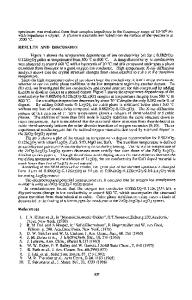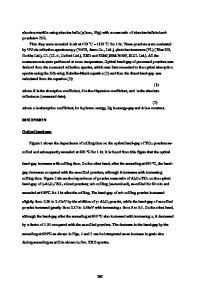Solution-Based Processing of Sc 2 O 3 Nanopowders Yielding Transparent Ceramics
- PDF / 615,414 Bytes
- 4 Pages / 612 x 792 pts (letter) Page_size
- 35 Downloads / 276 Views
A basic sulfate precursor [Sc(OH)SO4·2H2O] for well-sinterable Sc2O3 powders was precipitated from mixed solutions of scandium nitrate [Sc(NO3)3] and ammonium sulfate [(NH4)2SO4] at room temperature and which was subsequently converted to Sc2O3 via dehydroxylization and desulfurization at temperatures 艌900 °C. With the reactive powders synthesized in this work, polycrystalline Sc2O3 ceramics showing high inline transmittances of approximately 70% in the visible wavelength region (corresponding to ∼90% of the theoretical value of single crystals) have been fabricated via vacuum sintering at a relatively low temperature of 1700 °C.
Scandia (Sc2O3) is a cubic ceramic material possessing interesting optical and thermal properties but is difficult to grow as single crystals of high quality.1–3 In a previous paper,4 we reported the fabrication of transparent Sc2O3 polycrystals via vacuum sintering techniques, with powders thermally pyrolyzed from a sulfate salt [Sc2(SO4)3·7.8H2O] that we made. The sintered materials show inline transmittances of 56–58% in the visible wavelength region (∼400–770 nm), which is approximately 73% of the theoretical value (∼79%) of single crystalline Sc2O3. Better control of powder properties seems necessary to the further transmittance improvement. We have tried several wet-chemical techniques to synthesize Sc2O3 nanopowders via precipitation of oxy-hydroxide (␥-ScOOH)5 and oxalate precursors but failed to make transparent sintered bodies due to the poor powder reactivity arising from aggregation and/or large particle sizes. Recently, we found that more easily sinterable powders could be obtained from a basic sulfate precursor [Sc(OH)SO4·2H2O] precipitated from aqueous solutions, and Sc2O3 ceramics with a much higher inline transmittance of approximately 70% (∼90% of the theoretical value of single crystals) have then been made by the vacuum sintering technique. We report here the powder synthesis, characterization, as well as ceramics fabrication and optical properties.
stirring a scandium nitrate solution (0.4 M, 250 cm3) and an equivolume of ammonium sulfate [(NH4)2SO4, hereafter referred to as AS; analytical grade, Wako Pure Chemical Industries Ltd., Tokyo, Japan] solution. The resultant suspension, after 1 h homogenization, was filtered via suction filtration and washed repeatedly with distilled water. Free SO42− is hardly detected in the filtrate with saturated Ba(NO3)2 solution after five rounds of washing. After drying at room temperature with flowing N2, the precursor was calcined under flowing O2 (50 cm3/min) at various temperatures for 4 h to yield Sc2O3 oxides. The heating rate during the heating stage of calcination is 5 °C/min. Characterizations of the powders were achieved by chemical analysis, differential thermal analysis/thermogravimetry (DTA/TG), x-ray diffractometry (XRD), Brunauer–Emmett–Teller (BET) surface area analysis, and scanning electron microscopy (SEM). Sintering behaviors of the Sc2O3 powders were monitored in air via dilatometry, after isostatic consolidatio
Data Loading...











